2016 Chevrolet Camaro SS Coupe

WHAT WE LIKE: As we slide past 30,000 miles in the Camaro, we’ve filled its tank 122 times and are hanging onto a 20-mpg average, including a best tankful of 26 mpg. That average fuel economy is identical to our long-term Ford Mustang’s at this same milestone in its test. All of this matters not one whit, however. Because—and possibly you’ve noticed this about us—we don’t give two rips about fuel economy in this 455-hp pavement striper.
Mostly, things are as they have been. Staffers remain entranced by the Camaro’s engine sound, and many still can’t resist writing trite clichés in the Camaro’s logbook that use the words “gun” and “slit” to describe its visibility.
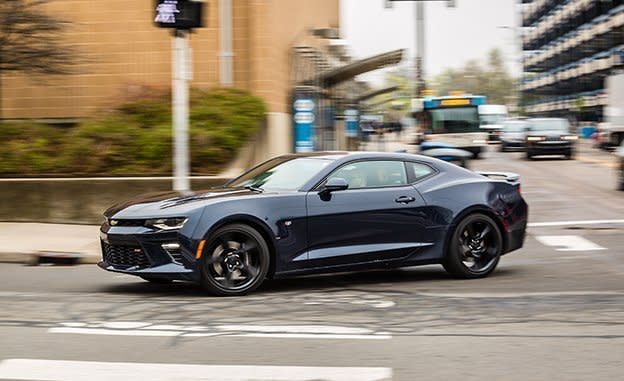
Others, however, took the time to call out some of the Camaro’s finer points, noting that, with the LT1 V-8, it puts Corvette-level performance within reach of the common man.
Despite its snarling persona, the Camaro proves on many occasions to be a big old teddy bear. Said one driver: “For all its performance, this car is very easy to drive around lazily with very little throttle.” Exploiting its wide bandwidth is something of a pastime around here—to the extent that some editors are calling it a GT car. At times, the Camaro is downright European in its manners, while always holding close to the surface its cocksure American roots.
Another editor summed it up nicely: “This thing can barely contain its rage. It’s a berserker.”
WHAT WE DON’T LIKE: A set of Pirelli Sottozero winter tires enabled the Camaro to nudge its way through a winter of mostly gloomy rain. Not a capable snow-goer, the SS nonetheless dug and slid and, eventually, found enough grip to move ungracefully under its own power in packed snow. This is not a winter car, even on winter rubber. Cold weather also revealed a shifter that became recalcitrant, even in temps as moderate as 40 degrees. First and reverse proved difficult to engage, although everything loosened up once the fluids came up to temperature.
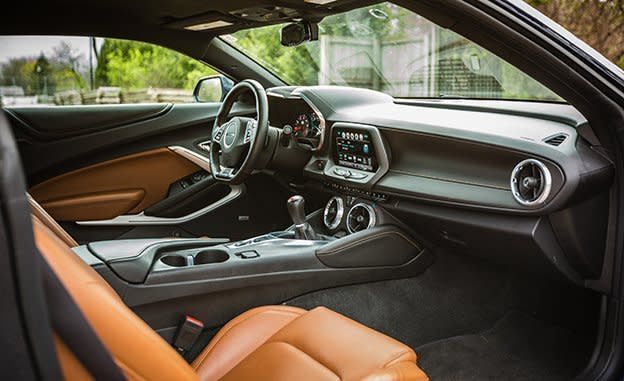
The Camaro lacks a dedicated button to cancel its cruise control, which annoyed more than one driver, and several found the Camaro’s Apple CarPlay interface infuriatingly reluctant to actually act like an Apple product, with complaints mostly centered on the inability to control specific apps.
Here’s the part where we complain about claustrophobia. Again. Virtually every positive comment in the logbook comes with the caveat that, yes, the Camaro’s remarkable power, noise, ride/handling balance, and overall presence is inescapably accompanied by a mention of its hopeless visibility and poor use of space.
WHAT WENT WRONG: Nothing went wrong with the Camaro, but its continued flirtation with dramatic oil consumption remains unsettling. We added 3.5 quarts of oil between 20,000 and 30,000 miles, two of which were the result of an underfilled sump at a local dealer at 21,700 miles. The other two quarts were consumption related, one of which was run through in less than 1800 miles, a rate far greater than the one quart every 4700 miles that Chevy dismissed as normal in our previous update. Nonetheless, the consumption proved inconsistent, as later checks showed no need to add oil. The oil was changed again at about 29,000 miles at a cost of $59. This time, the dealer remembered to pour in all 10 quarts.
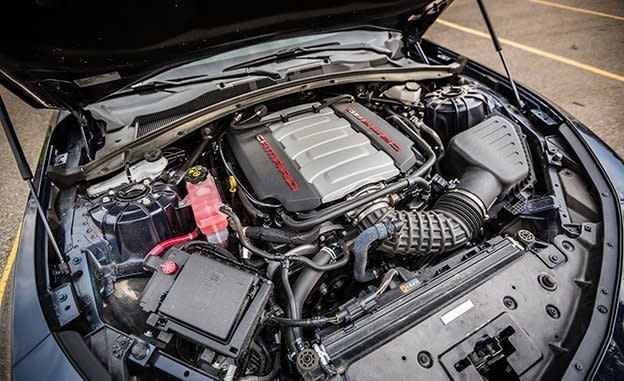
Otherwise, the Camaro has failed us precisely zero times, not once leaving us stranded or ever exhibiting mechanical or electrical problems. It is a tire-smoking picture of reliability.
WHERE WE WENT: Indiana and Ohio are the only states outside of Michigan that the Camaro visited since our 20,000-mile update. And besides a trip to Hicksville, Ohio, a place we’re tempted to shower in jokes, none of the journeys, including to Mulletsburg, Indiana, produced information of note.
Months in Fleet: 14 months Current Mileage: 30,849 miles
Average Fuel Economy: 20 mpg Fuel Tank Size: 19.0 gal Fuel Range: 380 miles
Service: $357 Normal Wear: $0 Repair: $0
Specifications >
VEHICLE TYPE: front-engine, rear-wheel-drive, 4-passenger, 2-door coupe
PRICE AS TESTED: $45,580 (base price: $37,295)
ENGINE TYPE: pushrod 16-valve V-8, aluminum block and heads, direct fuel injection
Displacement: 376 cu in, 6162 cc
Power: 455 hp @ 6000 rpm
Torque: 455 lb-ft @ 4400 rpm
TRANSMISSION: 6-speed manual
DIMENSIONS:
Wheelbase: 110.7 in
Length: 188.3 in
Width: 74.7 in Height: 53.1 in
Passenger volume: 85 cu ft
Cargo volume: 9 cu ft
Curb weight: 3718 lb
PERFORMANCE: NEW
Zero to 60 mph: 4.0 sec
Zero to 100 mph: 8.8 sec
Zero to 120 mph: 12.8 sec
Rolling start, 5–60 mph: 4.8 sec
Top gear, 30–50 mph: 9.2 sec
Top gear, 50–70 mph: 8.6 sec
Standing ¼-mile: 12.3 sec @ 118 mph
Top speed (C/D est): 165 mph
Braking, 70–0 mph: 150 ft
Roadholding, 300-ft-dia skidpad: 0.98 g
FUEL ECONOMY:
EPA city/highway driving: 16/25 mpg
C/D observed: 20 mpg
Unscheduled oil additions: 4.5 qt
WARRANTY:
3 years/36,000 miles bumper to bumper;
5 years/60,000 miles powertrain;
6 years/100,000 miles corrosion protection;
5 years/60,000 miles roadside assistance;
2 years/24,000 miles scheduled maintenance
Chevrolet’s all-new, sixth-generation 2016 Camaro is lighter and more powerful. It’s a more disciplined machine with meaningful control feel. Its steering, balance, and ability to engage its driver are all unquestionably improved relative to the car it replaces. None of that matters to the wider populace, because, let’s face it, Camaros are for burnouts. And rubber will be melted during this test, no doubt.
Truth is, the 2016 Camaro is good at a lot more than just frying the tires. It’s so comprehensively good, in fact, that it made our 10Best Cars list this year—an honor awarded to the Camaro only one other time since the award’s inception in 1983. And in 1985, when the IROC-Z won, competitors as strong as Ford’s Mustang Shelby GT350 didn’t exist. The Camaro earned its place among the elite with its standout performance and justified a long-term, 40,000-mile relationship.
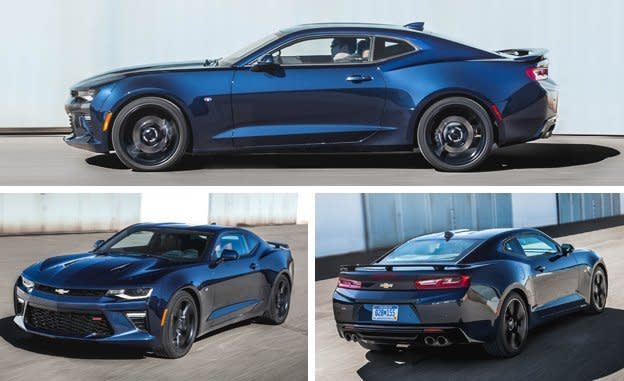
We ordered an SS coupe and then went heavy with the options. The net result is a $45,580 as-tested price. Camaros start at $26,695, albeit with a turbocharged 2.0-liter four-cylinder. But a Camaro with a four-banger is like seeing AC/DC with Pee-wee Herman standing in for Brian Johnson, er, Axl Rose. There’s also an optional V-6—and it’s fantastic—but we passed that over, too.
We said in the Camaro’s 10Best story that we’d build ours with a V-8, Magnetic Ride Control, and the dual-mode exhaust, and that’s exactly what we did. We also opted for Chevy’s MyLink audio system with an 8.0-inch touchscreen and Bluetooth streaming, along with Apple CarPlay and Android Auto capability. Options totaled $8285, including the $5000 2SS package, which adds conveniences such as a head-up display, Bose audio, heated and ventilated front seats, a heated steering wheel, dual-zone automatic climate control, and blind-spot monitoring.
Under the hood is Chevy’s 6.2-liter LT1 small-block V-8. In Camaro SS trim, it’s good for 455 horsepower and 455 lb-ft of tire-melting torque. Because we’re into saving the manuals around here, we kept the standard six-speed stick. Active rev-matching and a limited-slip differential acting on a 3.73:1 rear axle also are standard. Four-piston Brembo brake calipers peek through 20-inch front and rear wheels.
Four drive modes controlling throttle calibration, damper stiffness, stability control, exhaust sound, and more are standard, but the addition of optional MR (magnetorheological) dampers adds a more meaningful measure of control to the chassis in each mode.
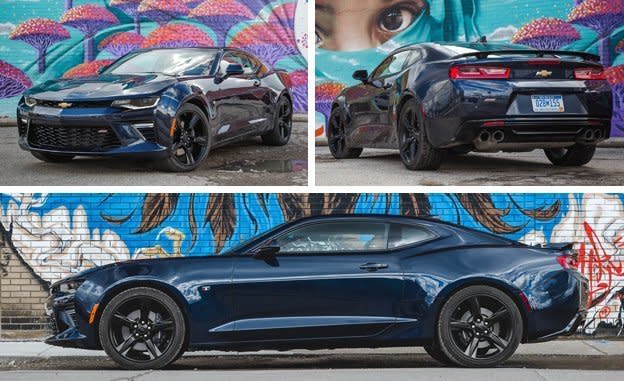
Early Impressions
Burnouts? Check. Powerslides? Check. Ride comfort? Check. Wait—what?
It’s true. The Camaro’s ability to smooth frost heaves and blaze through broken pavement is truly remarkable. U.S. 23 just north of the Ohio border, a section of road that tortured us in our long-term Ford Mustang GT and our (now-departed) Subaru BRZ, was far from punishing in the Camaro. Even Sport mode doesn’t yield a busy ride, while some staffers find Tour mode to be too soft in many situations. The difference between them is easily discernible.
A pony car demands a perfectly matched clutch/shifter combo, and Chevy nailed the balance here. The slick-shifting six-speed is superb in daily use, allowing the driver to swap cogs cleanly and quickly. Even the occasional need to slam home second gear in the middle of a slide is trivial with this transmission. The Tremec TR-6060 gearbox shrugs off machine-gun-quick shifts with its synchros intact.
The coupe’s 4.0-second zero-to-60-mph time is only 0.1 second behind what we measured in the eight-speed-automatic-equipped Camaro SS featured in our latest Mustang-versus-Camaro cage match. Our long-termer’s quarter-mile time matched that car at 12.3 seconds while smoking through the traps at 118 mph, 2 mph faster. More notably, it’s only 0.1 second and 1 mph behind the last Corvette Stingray we tested.

Handling was on par with previous SS trims, too. At 0.98 g on the skidpad, the Camaro’s lateral acceleration approaches the magic 1.00-g milestone and easily tops that of the Mustang GT. It’s also only 0.01 g off the mark set by the BMW M2. And that’s a sentence we were pretty sure we’d never write. Its stop from 70 mph in 150 feet was a full nine feet shorter than the Bavarian coupe despite carrying about 300 more pounds.
Although we’re still in the honeymoon period with this Camaro, it’s worth noting that its fuel economy to date is matching the EPA’s combined figure of 19 mpg. Certainly that’s due in part to easy driving during the initial break-in period, though, so we’ll be keeping an eye on it once our lead feet have had more opportunity to stomp with impunity.
Grumbles about tanklike visibility remain, but Chevy fixed the Camaro’s other major shortcomings, such as the cheap-looking interior materials, with this sixth-generation car. Whether those gripes will remain at bay will be determined over the next 36,000 miles.
Months in Fleet: 2 months Current Mileage: 3799 miles
Average Fuel Economy: 19 mpg Fuel Tank Size: 19.0 gal Fuel Range: 360 miles
Service: $0 Normal Wear: $0 Repair: $0
Specifications >
VEHICLE TYPE: front-engine, rear-wheel-drive, 4-passenger, 2-door coupe
PRICE AS TESTED: $45,580 (base price: $37,295)
ENGINE TYPE: pushrod 16-valve V-8, aluminum block and heads, direct fuel injection
Displacement: 376 cu in, 6162 cc
Power: 455 hp @ 6000 rpm
Torque: 455 lb-ft @ 4400 rpm
TRANSMISSION: 6-speed manual
DIMENSIONS:
Wheelbase: 110.7 in
Length: 188.3 in
Width: 74.7 in Height: 53.1 in
Passenger volume: 85 cu ft
Cargo volume: 9 cu ft
Curb weight: 3718 lb
PERFORMANCE: NEW
Zero to 60 mph: 4.0 sec
Zero to 100 mph: 8.8 sec
Zero to 120 mph: 12.8 sec
Rolling start, 5–60 mph: 4.8 sec
Top gear, 30–50 mph: 9.2 sec
Top gear, 50–70 mph: 8.6 sec
Standing ¼-mile: 12.3 sec @ 118 mph
Top speed (C/D est): 165 mph
Braking, 70–0 mph: 150 ft
Roadholding, 300-ft-dia skidpad: 0.98 g
FUEL ECONOMY:
EPA city/highway driving: 16/25 mpg
C/D observed: 19 mpg
Unscheduled oil additions: 0 qt
WARRANTY:
3 years/36,000 miles bumper to bumper;
5 years/60,000 miles powertrain;
6 years/100,000 miles corrosion protection;
5 years/60,000 miles roadside assistance;
2 years/24,000 miles scheduled maintenance
WHAT WE LIKE: Besides the Camaro’s ability to depart C/D World Headquarters at the end of a workday sideways in a plume of glorious smoke, you mean? Truth is, we’ve found a lot more to like. The most complimented items in our long-term Camaro’s logbook are power and ride comfort. That’s the Chevrolet Camaro SS in 2016: stupid fast and strikingly comfortable. The next most admired attributes? Handling and chassis composure. This Camaro can abbreviate apexes better than its legacy implies. Road trippers took to the Camaro’s long-distance comfort keenly, noting that both its seats and its suspension offer all-day capability. It’s hard to not like a sports coupe that’s fast and comfortable, disregards midcorner bumps, and demonstrates big grip.
Having its segment counterpart, the 2016 Ford Mustang GT, in our long-term fleet at the same time provides valuable perspective. Several editors noted that the Camaro’s clutch and shifter are easier and more intuitive to use than the Mustang’s—especially in stop-and-go driving.
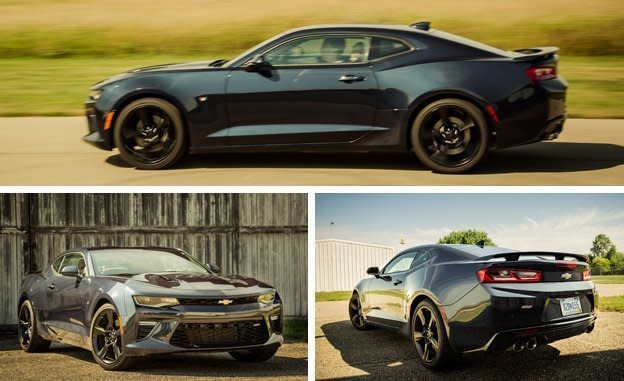
Other notable entries on the “likes” list include the exhaust sound (“Uncorking the LT1 makes the car,” said one editor) and the ergonomics. Even the small-diameter steering wheel, which is shared with the Corvette, is popular.
WHAT WE DON’T LIKE: Predictably, difficulty seeing out of the Camaro annoys many. Descriptors like “gun slit” and “periscope” litter the logbook with disturbing frequency. It’s “a nightmare for parking and low-speed maneuvering,” wrote one driver. Poor visibility is a deal breaker for many, who would gladly trade the Camaro’s performance for the clearer sightlines offered from the Mustang’s driver’s seat.
And although many like the Camaro’s interior, it’s also the second-most frequently griped about element. The vents, which are ringed by a rotating bezel to adjust climate-control temperatures, draw more criticism than accolades, primarily for low-on-the-dash positioning that translates to a chilly shifting hand. The infotainment screen, tilted slightly down to reduce glare, frustrated several editors who didn’t experience that benefit. For some drivers, the oversize cowl surrounding the instrument cluster further obstructs the view over the hood.
WHAT WENT WRONG: A highway-speed vibration appeared at 6400 miles; rebalancing all four wheels cured the problem before we used the Camaro to shuttle to our annual Lightning Lap tests in Virginia in June. The Camaro went in for its first recommended dealer service at 7500 miles—an uneventful oil and filter change at a cost of $68.41. However, at 11,600 miles, we added another 2.5 quarts of oil—an alarming 25 percent of its total capacity. With no evident oil leaks, the Camaro’s LT1 was either underfilled at the dealer or it’s burning oil. Evidence for the latter is mounting: Another check at 14,200 miles revealed the need for another quart of 5W-30. We will be carefully monitoring the Camaro’s oil consumption going forward. The only other dealer visit was for an Android Auto update at 2100 miles.
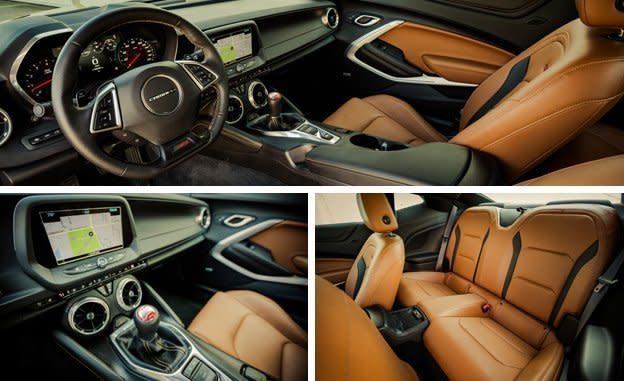
WHERE WE WENT: Multiple road trips to Indiana and Virginia proved the Camaro to be a worthwhile distance companion. More interesting than where we’ve gone is the 20 mpg the Camaro has achieved in 14,000 miles of leaden-foot driving; that’s 1 mpg higher than its EPA-estimated combined figure. Logbook notes reveal some editors enduring 1–4 skip-shift entanglements more often than they’d prefer, but let’s not forget that this is a Camaro that runs a 12.3-second quarter-mile and pulls 0.98 g on the skidpad, making it a stunning all-rounder.
Months in Fleet: 5 months Current Mileage: 14,262 miles
Average Fuel Economy: 20 mpg Fuel Tank Size: 19.0 gal Fuel Range: 380 miles Service: $68.41 Normal Wear: $0 Repair: $0
Specifications >
VEHICLE TYPE: front-engine, rear-wheel-drive, 4-passenger, 2-door coupe
PRICE AS TESTED: $45,580 (base price: $37,295)
ENGINE TYPE: pushrod 16-valve V-8, aluminum block and heads, direct fuel injection
Displacement: 376 cu in, 6162 cc
Power: 455 hp @ 6000 rpm
Torque: 455 lb-ft @ 4400 rpm
TRANSMISSION: 6-speed manual
DIMENSIONS:
Wheelbase: 110.7 in
Length: 188.3 in
Width: 74.7 in Height: 53.1 in
Passenger volume: 85 cu ft
Cargo volume: 9 cu ft
Curb weight: 3718 lb
PERFORMANCE: NEW
Zero to 60 mph: 4.0 sec
Zero to 100 mph: 8.8 sec
Zero to 120 mph: 12.8 sec
Rolling start, 5–60 mph: 4.8 sec
Top gear, 30–50 mph: 9.2 sec
Top gear, 50–70 mph: 8.6 sec
Standing ¼-mile: 12.3 sec @ 118 mph
Top speed (C/D est): 165 mph
Braking, 70–0 mph: 150 ft
Roadholding, 300-ft-dia skidpad: 0.98 g
FUEL ECONOMY:
EPA city/highway driving: 16/25 mpg
C/D observed: 20 mpg
Unscheduled oil additions: 3.5 qt
WARRANTY:
3 years/36,000 miles bumper to bumper;
5 years/60,000 miles powertrain;
6 years/100,000 miles corrosion protection;
5 years/60,000 miles roadside assistance;
2 years/24,000 miles scheduled maintenance

 Yahoo Autos
Yahoo Autos 